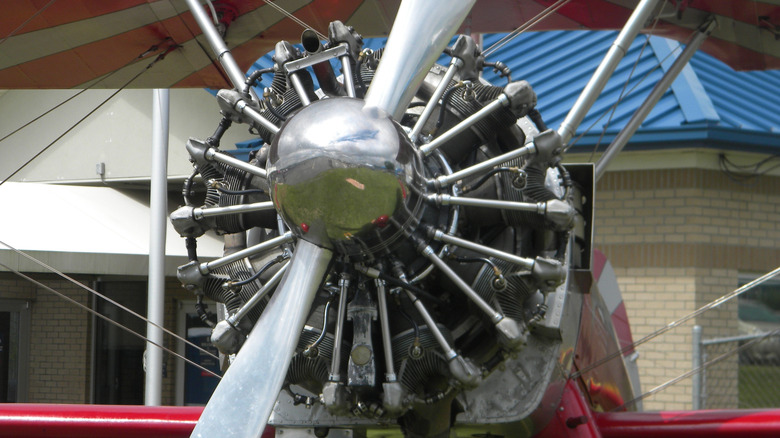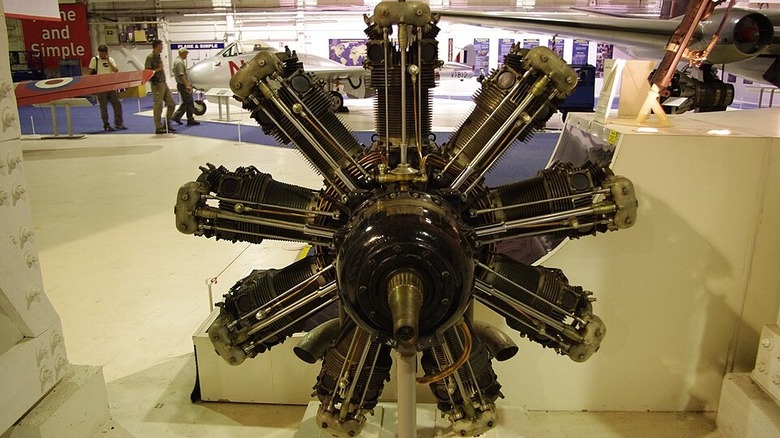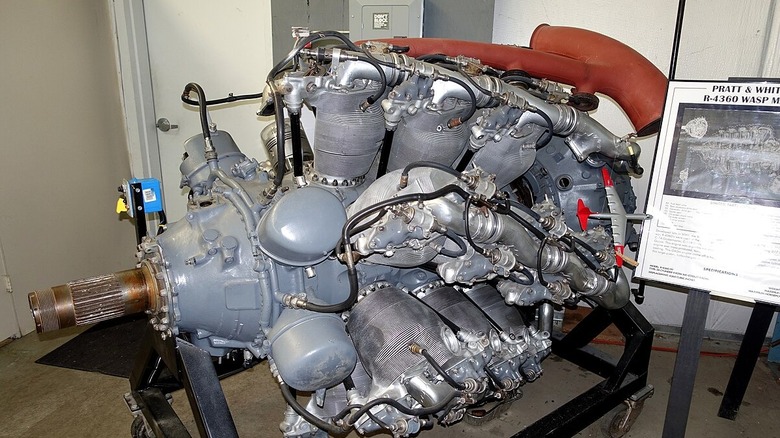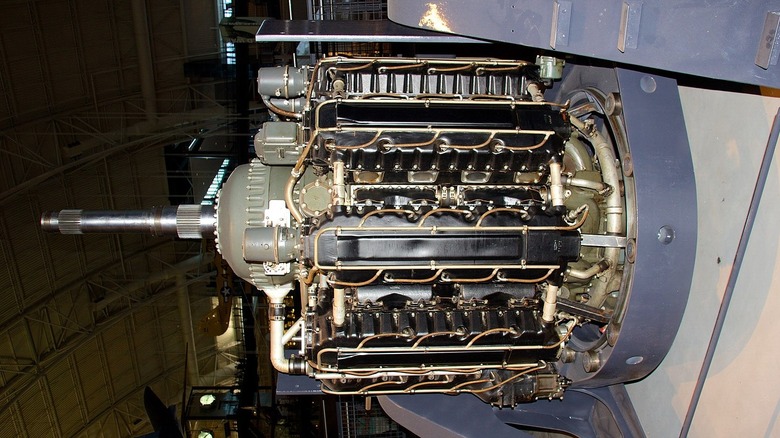5 Of The Most Iconic Radial Engines Ever Put In Tanks Or Planes
The 20th century was the age of the internal combustion engine. The fruits of industrial progress produced power plants tasked with everything from running generators to powering warplanes. The First and Second World Wars placed a premium on developing new technologies and configurations. The radial engine began showing up in the first decade of the 20th century and served notably in several machines, the most famous of which were tanks and airplanes.
A radial engine is an internal combustion engine, like a V8 or straight-six, but its cylinders are arranged in a 360-degree radius around a crankshaft. The configuration first appeared in the early 1900s. Air-cooled radials provided weight savings over systems requiring water pumping and cooling systems. Radial engines also proved durable and reliable, leading engineers and designers to turn to them for military and aviation applications.
Radials aren't used much anymore outside of custom and niche projects, but they evolved through the exigencies of two World Wars and benefited from decades of development. They might not be powering most modern machines, but radial engines performed in tanks and planes during some of the most critical points in history.
Bristol Jupiter VIII
The years between the First and Second World Wars were a nascent time for aviation technology. Engineers and pilots used lessons learned during the First World War to develop peacetime aviation technologies. The Bristol Jupiter VIII was one of England's notable radial engines of the 1920s and 1930s.
When Bristol Aeroplane acquired Cosmos Engineering in 1920, it took possession of plans for the Jupiter. Many of the top fighter aircraft of World War I used rotary engines, but the radial appeared to be the way of the future. Bristol invested in the design, and the resulting Bristol Jupiter revolutionized interwar aviation in Britain.
The Jupiter used nine cylinders totaling 29 liters to produce 460 hp. Its reliable function made it a top-tier candidate for aviation, and the Jupiter helped expand aviation. The Royal Air Force (RAF) made the Jupiter its official interwar engine in 1923. Between Bristol and licensees, over 7,000 Jupiters were manufactured and incorporated into 262 aircraft.
Pratt & Whitney Wasp
Pratt & Whitney's Wasp-series radial engines did as much as any powerplant to guide U.S. Forces to victory during World War II. It became so iconic that it is the only aircraft engine to be designated a historical landmark. Pratt & Whitney was a toolmaker that invested in radial engine technology. Its nine-cylinder R-1340 Wasp arrived in 1925, finding work in the Boeing F2B-1 and Ford Trimotor.
The success of the Wasp catapulted Pratt & Whitney into one of the top aircraft engine producers in the world, building engines for the F-35 Lightning II and the speed demon F-22 Raptor. The Wasp grew through the Second World War, all the way up to the R-4360, a 28-cylinder, 3,500-hp air-cooled radial that powered early Cold War bombers and cargo planes such as the B-35 Flying Wing, C-74 GlobeMaster, and C-119 Flying Boxcar. Yet no other P&W engine is as iconic as the R-2800 Double Wasp.
Twin banks of nine cylinders each made the Double Wasp a water-injected, twin-charged 2,400 hp monster that powered the Grumman F6F Hellcat, Vought F4U Corsair, Republic P-47 Thunderbolt, and many other warplanes to victory during World War II. The robust radial even enjoyed a significant post-war career, powering early commercial airliners until 1960. All told, more than 125,000 Pratt & Whitney R-2800s alone changed the shape of military and commercial aviation.
Continental R/W-670
Bringing things back down to earth, we arrive at radial-powered tanks. The First World War didn't just showcase the rise of flight — it also brought about the age of tanks. With the internal combustion world still in its infancy, tank designers were eager to find out if these new-fangled radial engines had any application on the battleground.
The Continental R/W-670 was a seven-cylinder radial engine developed for light aircraft in the 1930s and 1940s. It powered Boeing Stearman PT-17 and Fairchild PT-23 military training aircraft and small numbers of civilian aircraft. It was powerful enough for its purpose, bringing about 225 horsepower to the table.
Radial's light weight and robust, simple design could work as well in tanks, and that is how it made its way into the M2 Light Tank and T4 Combat Car before World War II. While certainly good for Continental's bottom line, what makes the R/W 670 iconic was its service in World War II in early M3 Stuarts and M4 Sherman tanks. These two armored vehicles helped stave off disaster during World War II as reliable, mass-produced war machines to field against the fascist menace.
Wright R-1820 Cyclone
Civil aviation took off in the interwar years with aircraft like the Douglas DC-3. Hitting the sky in 1935, the Douglas DC-3 is still flying today. Part of that longevity is its dual Wright SGR 1820 nine-cylinder radial engines. The DC-3 was the first airliner profitable enough to operate without receiving government subsidies.
The Curtiss Aeroplane and Motor Corporation merged with the Wright Aeronautical Corporation, the company of the Wright brothers, in 1929 to become Curtiss-Wright. The company would go on to develop radial engines and other aircraft technology for the better part of the mid-century. The Cyclone series began in 1924 as a request from the Navy for a nine-cylinder air-cooled radial. The initial Cyclone engines made 575 hp, but with such a long career, the Cyclone evolved side-by-side with Pratt & Whitney's Wasp until later versions ultimately made as much as 1,200 hp.
Particularly attractive to commercial operators was a reduction gear that eliminated direct drive, improving efficiency by allowing the propeller to spin separately from the engine. Combined with durable operation, what makes the Wright Cyclone iconic isn't power, but reliability. Officials and pilots could count on the Cyclone so thoroughly that it made regularly scheduled air routes possible — an enormous step toward standardizing logistical and transportation civil air travel. Wright continued to build ever-larger Cyclones for military and civil applications into the 1950s.
Lycoming XR-7755-3
With the advent of radial engine technology paving the way for the exciting rise of the jet age, development dollars dried up, and manufacturers pivoted to turbine technology. But not before someone built what stands as the largest and most powerful radial engine ever built: the Lycoming XR-7755.
Lycoming got its start as part of the E.L. Cord empire, which built engines for car manufacturers like Cord, Duesenberg, and Auburn. Though its auto partners would go defunct, Lycoming carried on as World War II broke out, developing enormous engines for various applications. No replacement for displacement was the order of the day, and aircraft and engines grew heavier and more powerful.
Toward the end of the war, Pratt & Whitney's 28-cylinder R-4360 Wasp Major was making 3,500 hp heading into the final days of World War II. Lycoming's newcoming XR-7755-3 was slated to take over in the post-war world until jet technology intervened. With four banks of nine cylinders each, the 127-liter, 36-cylinder made 5,000 hp each — in tests.
The XR-7755-3 is included on our list primarily for its iconic status rather than its operational role. The biggest and most powerful radial engine ever built was built only twice. The two XR-7755-3s were tested on dynanometers but never integrated into an airframe, primarily due to the rapid advancement of jet technology over piston internal combustion.





